Students discover a new Maya king in the lost city of Jaguar Hill in Guatemala
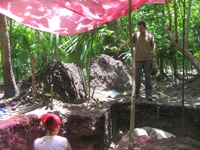
MIDDLEBURY, Vt. - It is not often that college students discover evidence of a new Maya king. Yet that is what happened when Middlebury junior Ben Grimmnitz and sophomore Jacqueline Montagne traveled to Guatemala last June to the lost city of Jaguar Hill. The two students
are among the first people to excavate the site, which remained hidden for millennia in the jungle near the modern-day town of Vistahermosa. While
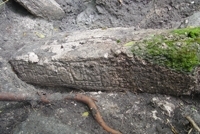
Photo courtesy of James Fitzsimmons, Northwest Petén Project
working alongside Middlebury College Visiting Assistant Professor of Anthropology James Fitzsimmons for an archeology project titled “Proyecto Petén Noroccidente” (Northwest Petén Project), they unearthed royal artifacts and stone monuments inscribed with hieroglyphs that told of the life of the previously unknown Maya monarch.
Initiated in 2004, Proyecto Petén Noroccidente is an international effort to understand ancient Maya state formation and development. Directed by Fitzsimmons and co-directed by Laura Gamez of the University of San Carlos in Guatamala, the project is focused on how the Maya city of Jaguar
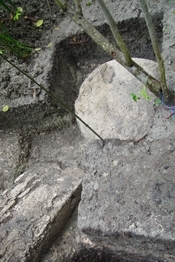
Hill formed and survived with a web of larger, historically robust kingdoms whose leaders are described in hieroglyphs as having captured, killed and even married the nobility from Jaguar Hill. Despite this notoriety, the site had been hardly noticed by contemporary archeologists until the discoveries by Fitzsimmons’ team contributed significantly to the historical understanding of the city and its royal families.
Grimmnitz and Montagne came to Guatemala after Fitzsimmons’ earlier research had revealed a number of inscribed stone pillars and altars, called “stelae,” which once stood on a plain that stretched before the city’s royal palace. The stelae are rich in history, describing the city’s ancient leaders with pictographs and portraiture.
“Such large galleries of stelae are unheard of in the Maya area, with perhaps the closest analogue being the Great Plaza at the famous site of Copan, in Honduras,” said Fitzsimmons. “Archeologists in
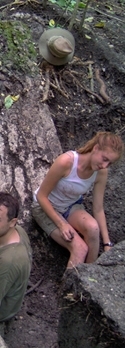
Guatemala today are generally lucky to find a few stelae during a period of several years. In three months, this project recovered 35 - totaling more than 45 during its two-year period.” According to Fitzsimmons, the large number of stelae is more in keeping with excavations of only a handful of major urban centers - which Jaguar Hill was not. “We know it was only a medium-sized city of the Classic Period, which lasted from 250-850 B.C. It was occupied for 150-200 years when most major cities of that era were occupied for five times as long,” he said. “When considered relative to these other cities, it appears the inhabitants sought to create a major city with a manufactured past in an extremely short period of time.”
Fitzsimmons suspected more stelae were buried in the courtyard of the palace ruins, and he formed a small excavation team - with Grimmnitz, Montagne and two additional students from the University of Vermont - to find them. In the next few weeks, they uncovered three additional stone monuments, two of which bore portraits and hieroglyphs. The third was a rounded altar approximately two meters in diameter, which Fitzsimmons believes was a companion piece to one of the monoliths. In addition to authenticating events in the life of the new Maya king, the inscriptions confirmed the identification of the city by the ancient Maya name of Hix Witz, which means jaguar hill. The newly discovered stelae appear to describe the king’s performance of ritual bloodletting and the deposition
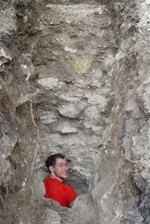
of sacred goods. The students also dug up a cache of ritual plates, knives and other wares set by the ancient Maya for a dedication ceremony more than 1,200 years ago.
Fitzsimmons explained that major excavations only began at the site in 2005 and that Grimmnitz, a sociology and anthropology major, and Montagne, a classics major, being among the first people ever to work at the site, have significantly contributed to the limited knowledge of Jaguar Hill. “Most Maya archaeologists have not had this experience, and those that have generally had to wait until graduate school or beyond. There are few projects worldwide that offer undergraduates the experience of actually excavating a monument, to be the first to see it in more than a millennium,” he said. “Given that finding intact monuments in the Maya area is rare at best, I am awed by the depth of history illumined by our discoveries at Jaguar Hill. I am particularly
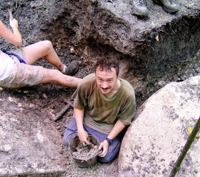
pleased that, by teaching Ben and Jackie archaeological field techniques while engaged in some of the most glamorous excavation in
Mesoamerica, I’ve been able to share that sense of wonder with them.”
Montagne described the students’ typical day as beginning with a quick breakfast of
refried beans before arriving at the site at 7:30 a.m. Once there, they unloaded the work truck and excavated until quitting time in the late afternoon. “We were all blown away when we discovered figurine heads and obsidian blades,” she said, “but closing time was the most anticipated hour each day. We worked hard, slept well and I built muscles I didn’t know I had. My favorite excavation tools were my own two hands.”
Augmenting their experience at Jaguar Hill, which was funded by a Middlebury College undergraduate collaborative research grant, Grimmnitz and Montagne learned about Maya royal architecture firsthand with pyramids and a royal palace on Fitzsimmons’ guided tour of famous Maya sites. They were instructed in the aftereffects of looting and explored looters’ tunnels to the entrance of a royal tomb. Descending into the tomb, which was a small room the size of a typical college dormitory, they discussed the negative impact that looting has had on the Maya area, and identified types of information still obtainable from looted historical sites.
“My experience with the crew in Guatemala has me leaning toward archaeology when I go to pursue classics in graduate school. I have a much better understanding of what archaeologists do and their passion for the discovery of history,” said Montagne. “Furthermore, my front-row view of a rural village in Central America has given me a whole new perspective on the world outside the United States.”
The students’ work is currently under revision for print in an Informe Preliminar, which is an informal publication produced under the auspices of Director of Monuments for the Guatemalan Ministry of Culture Salvador Lopez. Fitzsimmons plans to feature the students’ work in future submissions to academic journals.

